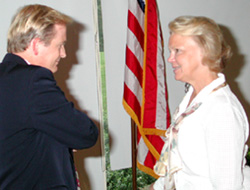|
|

Jan Nestler talks with Dr. Bill Crounse after Friday’s meeting.
|
Dr. Bill Crounse, longtime local physician, who has had a career in disseminating public information, appeared as DrGoodwell.com and gave the BBRC a look into the near-future relationship of doctor and patient.
The doctor talked about Overlake Medical Center and how it’s grown. “The growth of Overlake Hospital directly corresponds to the growth in Bellevue and the Eastside.” The hospital medical center occupies 19 acres, which includes the new six-story medical office tower that is now fully occupied. There is a new lobby at the main hospital entrance, and the center has just opened nine new operating suites.
“All of this has been a $25 million project,” said Crounse. With a new cancer treatment center in operation, a $48 million capital campaign to pay for these upgrades is underway.”
“Raising capital for a challenged Industry” was Crounse’s topic. He pointed out that the hospital industry faces rising costs, declining reimbursements, shrinking profits, an aging workforce (average age for nurses is 46) and an unappealing future.
Ken Graham, Overlake CEO, began asking the question: What’s the difference between valuation of an industry like Microsoft and Overlake Hospital? The difference is intellectual capital. But, doesn’t a hospital have intellectual capital as well? The answer lies in being a survivor. The hospital leadership began putting to work that capital, and this work has yielded the Overlake Venture Center, a for-profit subsidiary of OHMC, and has become a leader in Health care innovation.
Venture #1 – The Internet is causing a dramatic change in doctor-patient relationship. People are using the internet to seek health information more than any other. Information is wanted from the patient’s own doctor.
The physicians’ side of this issue is them being taken from their comfort zone – face-to-face contact versus the impersonal experience of the new technology. Patients can easily surpass a doctor’s knowledge with the internet. Recent studies show that 89% of doctors have internet access, and 91% use email. But, doctors exchanging emails with patients rates only 5%, while 70% of patients would like contact by this method with their doctors.
Along comes an opportunity. A chance for the Venture Center to find out more about the use of medical information on the internet. A program was designed to show employers how accessing such a program might be good for employees. Boeing asked for a survey, followed by Safeco and other companies. “I was floored when Microsoft called and asked for help in this area. What am I going to teach Microsoft about surfing the Internet?” queried Dr. Bill.
A journey ensued. Microsoft posed the question: How do you find good health care information on the Net? What if 40,000 MS employees could email you, Dr.Crounse, and pose health care questions? Soon, Dr.Crounse was doing a regular newsletter for employees on the Microsoft benefits page.
Microsoft employees were very respectful of a doctor’s time. “Something happened. Use increased as the project gained acceptance. Patients need information, not appointments. And, when they need medication, they need medications, not visits.
Overlake Venture Center spawned Dr. Goodwell. The program is built on (1) trusted medical information, (2) secure physician/patient E-messaging system, and (3) virtual clinic medical services. “Today, going to the doctor becomes an all-day venture. Overlake Venture Center is selling a new product for employees, physicians, and employers. A program that opens new vistas in communication between doctor and patient.”
Next, Dr. Crounse showed a short video on the reenactment of a real encounter between physician/patient under the Dr.Goodwell model. This part of the presentation shows how the system works. The virtual visit includes a video connection between patient and doctor. Patient describes symptoms, in this case a sore elbow. The doctor asks patient to extend arm. Chart pops up on web to show patient what’s happening to elbow. Diagnosis is Tennis Elbow. Doctor prescribes immediately online and the prescription is delivered to the patient’s workplace within a couple of hours. Follow-up includes checking back in about a week.
Dr. Goodwell model features in-office visits, video-enabled office visits, and secure email consultations, which yield qualified health information. The final solution is the current model of an actual office visit, the one that takes a better part of a day and conjures up all the stories about reduced productivity. At this point, insurance companies are not yet backing this model. Dr.Goodwell is working with large insurers, Fortune 100 companies, to get the concept established.
For more information about Dr. Goodwell, go to the Overlake Hospital Medical Center’s website. Or, you can contact Michelle at the Venture Center.
During question time, Dr. Crounse estimated the cost of email visits at “$20-$25 … going to the next level of virtual visit would be priced approximately $50-$55.” This method reduces hassle and lost production time, while doctors are able to block out time for virtual visits.
To get this to work, a company could provide a room set aside for virtual clinic visits. “All you’d need is a USB port, a $50 camera, and a DSL line.”
A question was voiced about malpractice insurance and whether it would cover doctors’ activities in a virtual atmosphere. Dr. Crounse said that “improving delivery of health care would reduce risks. That should be our prime goal.” How are doctors receiving this? “It’s a new game for them and they need to recognize this is for the benefit of the employee (or patient), the physician, and the employer.” Sounds like a win-win-win situation. Thanks to Jenny Andrews for her introduction.
Sagebrush tea is prescribed.
|